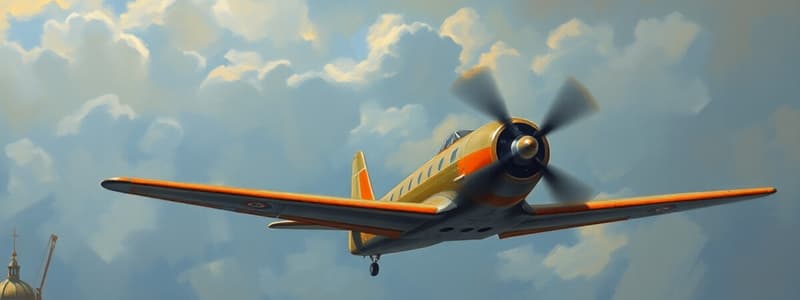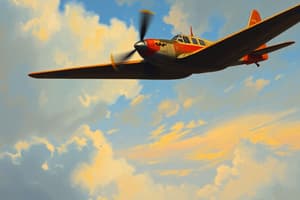Podcast
Questions and Answers
Who is credited with the concept of the Anthropometric man?
Who is credited with the concept of the Anthropometric man?
- Sigmund Freud
- Kurt Lewin
- Leonardo da Vinci (correct)
- Frank Gilbreth
What communication protocol developed by Frank and Lillian Gilbreth is used in air traffic control today?
What communication protocol developed by Frank and Lillian Gilbreth is used in air traffic control today?
- Signal lights
- Verbal repetition (correct)
- Non-verbal signals
- Written commands
In which era did aviation human factors considerations begin to take shape?
In which era did aviation human factors considerations begin to take shape?
- Late 1800s
- 1950s
- Early 1900s (correct)
- World War I
What significant law was passed in 1988 concerning human factors in aviation?
What significant law was passed in 1988 concerning human factors in aviation?
Which World War II factor prompted research into human factors by military researchers?
Which World War II factor prompted research into human factors by military researchers?
What incident in 1988 raised public concern about aviation maintenance human factors?
What incident in 1988 raised public concern about aviation maintenance human factors?
During which decade did the FAA conduct extensive research on maintenance human factors?
During which decade did the FAA conduct extensive research on maintenance human factors?
Who were the early 20th-century industrial engineers that studied medical operating procedures?
Who were the early 20th-century industrial engineers that studied medical operating procedures?
What was a key reason for the consideration of human factors in aircraft design during the early 1900s?
What was a key reason for the consideration of human factors in aircraft design during the early 1900s?
What incident in 1988 raised public concern about human factors in aviation maintenance?
What incident in 1988 raised public concern about human factors in aviation maintenance?
Which psychologists conducted significant work related to human factors in their time?
Which psychologists conducted significant work related to human factors in their time?
The Aviation Safety Act passed in 1988 mandated research on human factors in which area?
The Aviation Safety Act passed in 1988 mandated research on human factors in which area?
What was one of the contributions of Frank and Lillian Gilbreth in the early 1900s?
What was one of the contributions of Frank and Lillian Gilbreth in the early 1900s?
Which organization was established in 1957 and is focused on human factors?
Which organization was established in 1957 and is focused on human factors?
What was a major focus of government research during World War II regarding pilots?
What was a major focus of government research during World War II regarding pilots?
Which key figure is associated with the study of anthropometrics in relation to human factors?
Which key figure is associated with the study of anthropometrics in relation to human factors?
What significant aspect of communication was highlighted in air traffic control practices?
What significant aspect of communication was highlighted in air traffic control practices?
When did the FAA begin extensive research on maintenance human factors?
When did the FAA begin extensive research on maintenance human factors?
Flashcards
Human Factors
Human Factors
The study of how people interact with tools, machines, and systems, and how to make them better.
Anthropometrics
Anthropometrics
The study of human body measurements, such as size and strength.
Gilbreths' Research
Gilbreths' Research
Early 20th-century industrial engineering work studying medical procedures.
Verbal Protocol
Verbal Protocol
Signup and view all the flashcards
Aviation Human Factors
Aviation Human Factors
Signup and view all the flashcards
WWII Aircraft Design
WWII Aircraft Design
Signup and view all the flashcards
FAA Maintenance Research
FAA Maintenance Research
Signup and view all the flashcards
Human Factors Training Guidelines
Human Factors Training Guidelines
Signup and view all the flashcards
Human Factors Discipline
Human Factors Discipline
Signup and view all the flashcards
Human Factors in Maintenance
Human Factors in Maintenance
Signup and view all the flashcards
Aviation Safety Act
Aviation Safety Act
Signup and view all the flashcards
Human Factors Society
Human Factors Society
Signup and view all the flashcards
International Ergonomics Association
International Ergonomics Association
Signup and view all the flashcards
1950s US Air Force Experiment
1950s US Air Force Experiment
Signup and view all the flashcards
Historical Beginning of Human Factors
Historical Beginning of Human Factors
Signup and view all the flashcards
Leonardo da Vinci's Contribution
Leonardo da Vinci's Contribution
Signup and view all the flashcards
Gilbreths' Verbal Protocol
Gilbreths' Verbal Protocol
Signup and view all the flashcards
Freud and Lewin's Contribution
Freud and Lewin's Contribution
Signup and view all the flashcards
Early Aviation Human Factors
Early Aviation Human Factors
Signup and view all the flashcards
WWII Impact on Human Factors
WWII Impact on Human Factors
Signup and view all the flashcards
USAF Personality Matching (1950s)
USAF Personality Matching (1950s)
Signup and view all the flashcards
Aviation Safety Act (1988)
Aviation Safety Act (1988)
Signup and view all the flashcards
Human Factors in Maintenance (1990s)
Human Factors in Maintenance (1990s)
Signup and view all the flashcards
Anthropometrics in Human Factors
Anthropometrics in Human Factors
Signup and view all the flashcards
Human Factors Research in Aviation
Human Factors Research in Aviation
Signup and view all the flashcards
Early Human Factors Research
Early Human Factors Research
Signup and view all the flashcards
Human Factors & Ergonomics Society
Human Factors & Ergonomics Society
Signup and view all the flashcards
Human Factors: More than Just Theory
Human Factors: More than Just Theory
Signup and view all the flashcards
Human Factors: History and Beginnings
Human Factors: History and Beginnings
Signup and view all the flashcards
Study Notes
Historical Beginnings of Human Factors
- Defining precise origins is difficult, but Leonardo da Vinci's "Anthropometric Man" (1452-1519) is a reference point for anthropometrics (human size and strength).
- Industrial engineers Frank and Lillian Gilbreth (1868-1924 and 1878-1972) studied medical procedures and developed the verbal protocol (repeating commands) for clear communication – still used in air traffic control.
- Psychologists Freud (1856-1939) and Lewin (1890-1947) contributed to human factors research.
Aviation Human Factors
- Early 1900s saw aircraft designers considering human factors in design.
- Military research also focused on pilot medical factors around this time.
- World War II mass production of military aircraft forced engineers to account for pilot compatibility with control designs.
- Personnel matching efforts emerged during the 1950s, including experiments evaluating human personalities.
- The 1988 Aviation Safety Act spurred FAA research on all aviation human factors including maintenance, following a 1988 mid-air break-up accident.
- FAA research in the 1990s created regulatory guidelines for human factors training, forming the basis of current materials.
Current Status of Human Factors
- Human factors today is more practical than previously - maintenance personnel actively participate in discussions.
Human Factors Societies
- Human Factors and Ergonomics Society (HFES):
- Founded in 1957.
- Approximately 5,000 members.
- Roughly 50/50 psychology and engineering members.
- Active in 49 U.S. states and 42 countries.
- International Ergonomics Association (IEA):
- Founded in 1959.
- Composed of 42 federated societies.
Studying That Suits You
Use AI to generate personalized quizzes and flashcards to suit your learning preferences.
Description
Explore the foundational contributions of key figures in human factors, from Leonardo da Vinci's anthropometrics to the studies by the Gilbreths and significant developments during World War II. This quiz covers the evolution of human factors in aviation and how they've influenced design and safety measures in the industry.




